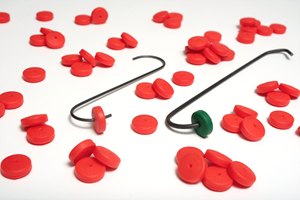Parts Draining During E-coat
At the end of the process, when the body gets out of the E-coat bath, sometimes incomplete draining of the body can occur and this can produce problems during the baking phase. Could you tell me more about the nature of these problems? Do some special methods exist to avoid bad draining problems?
Q. I have a few questions about E-coat issues in the automotive industry. At the end of the process, when the body gets out of the E-coat bath, sometimes incomplete draining of the body can occur and this can produce problems during the baking phase. Could you tell me more about the nature of these problems? Do some special methods exist to avoid bad draining problems? V.A.
A. This is a good question and an important manufacturing consideration not only for the quality of the coating but also for the E-coat system itself. During the early 1990s I spoke at several Society of Manufacturing Engineers (SME) coating workshops where this topic came up often. Those in attendance were manufacturing engineers and processing people, not design engineers.
Unfortunately, the coating process is probably one of the last things on the designer’s mind when the design for a part is created. As a result, the part design often creates traps for fluids when parts are racked in the most efficient configuration for E-coating. If not corrected with special fixtures and possibly rotations, those traps cause liquids to be transferred (carried over) to other tanks. often causing chemical problems with the process. Trapped fluids can also be carried into the curing oven where they may boil, steam and pop. This would cause blemishes and defects in the coating film.
Special fixtures to cause the parts to move in a way that will drain fluid from the traps are often the solution. In other cases, the part design is re-considered and in some cases drain holes can be provided. In either case, it should be an integral part of the pre-production prove-out process to consider drainage issues prior to the time the part design is released to production.
Back when I had a real job, we worked with several automotive frame coating projects. Prototype frames were always evaluated for drainage issues and design changes were often recommended and made to ensure proper drainage. In some cases, E-coat system design was modified to maximize the coating efficiency while minimizing drainage issues. We became aware of one company that took on a job to coat frames without going through that procedure, and the drainage problems were not discovered until after the frames were released to production. The consequences were catastrophic.
Now for a drainage case with a heavy subject that ended on a lighter note. In the late ’80s, I was involved in a project where our company designed, built and operated an E-coat system for very large castings for construction equipment. One particular casting weighed more than a ton. The heavy-duty E-coat system was designed with a process for coating and curing the part, but there was a recessed area in the upper portion of the large casting that could not be drained because the part was too big and heavy to manipulate. The E-coat system was a square transfer design, and product was accessible at each tank from the catwalk. So, the solution to the drainage issue was to assign an employee to use a suction hose and remove the liquid from the recessed area after each treatment tank.
When I was observing that operation, I asked the young man who was assigned to do that how he liked his job. He said that he has a lot of fun with it. The first day he had the job was his birthday and that night at his birthday party he announced to all of his friends that he had a new job title. He told them that he had been promoted to “Puddle Sucker.” What a great sense of humor!
Related Content
Conveyors and Paint Systems
Choosing the right conveyor system, coating technology, and ancillary equipment.
Read MoreTTX’s Automated Conveyor Carrier System Offers Wireless, Flexible Operation
ACC system designed for reliable, consistent point-to-point movement of everything from small to heavy parts.
Read MoreCFS Unveils New Hook Locks Parts Racking Solution
New product from Custom Fabricating & Supplies (CFS) prevents part loss during coating processes.
Read MoreAn Altruistic Growth Strategy Puts People First
Professional Plating emphasizes investing in its team and fostering a supportive environment on the shop floor.
Read MoreRead Next
Delivering Increased Benefits to Greenhouse Films
Baystar's Borstar technology is helping customers deliver better, more reliable production methods to greenhouse agriculture.
Read MoreA ‘Clean’ Agenda Offers Unique Presentations in Chicago
The 2024 Parts Cleaning Conference, co-located with the International Manufacturing Technology Show, includes presentations by several speakers who are new to the conference and topics that have not been covered in past editions of this event.
Read MoreEducation Bringing Cleaning to Machining
Debuting new speakers and cleaning technology content during this half-day workshop co-located with IMTS 2024.
Read More












.jpg;maxWidth=300;quality=90)











